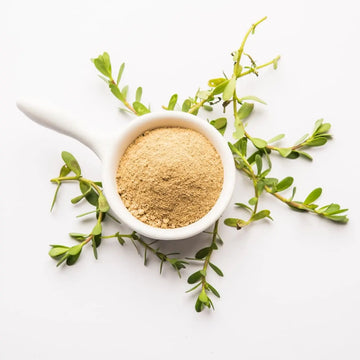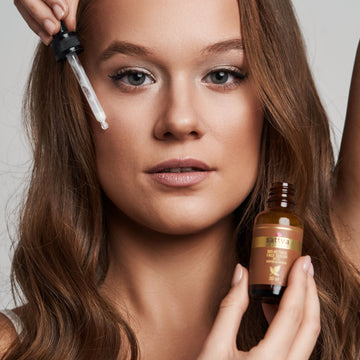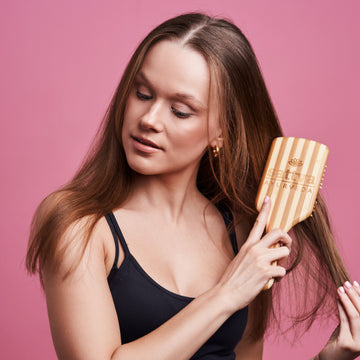A unique ritual not only for the body: discover Ayurvedic massage oils
Specialized treatments are performed by a specialist or Ayurvedic doctor in a cleansing process called panchakarma. At the same time, body oiling combined with massage is a wonderful ritual that Ayurveda recommends doing regularly at home. In this article, you will learn why it is worth it and how to do it properly.
Although the oiling technique may vary depending on individual needs and preferences, there are some general principles that are worth following. First of all, it is worth familiarizing yourself with the concept of Ayurvedic supply. Doshas are subtle energies, the effects of which we can observe in ourselves and others, both in the structure of the body, the quality and type of tissues (skin, hair), and at the level of physiology and psyche.
What dosha are you?
It is important to note that there are always three doshas in every person, but usually one or two of them are more dominant. Read the short descriptions below to get a feel for what I mean. This will allow you to assess which dosha is dominant in you now, or maybe it is already getting out of control (this is when the more troublesome symptoms appear).
When the Vata dosha dominates
If a person is Vata dominant , they are likely to be very petite or very tall, have dry skin and are sensitive to cold and dry weather. They tend to sleep quite shallowly and restlessly. They may be active, enthusiastic, open and creative, but their energy levels are likely to be variable. If the VATA dosha level increases (with age or due to poor diet or lifestyle), they will be prone to nervous disorders and struggle with joint problems, allergies, constipation and anxiety.
When the Pitta dosha dominates
If Pitta is dominant in a person , they are likely to be of average build, with warm, ruddy skin. In summer, they are sensitive to the sun (they never leave the house without sunglasses) and are prone to sunburn. They usually have a fairly strong appetite. If they skip meals, they become irritable. They sleep alertly but well and satisfactorily. In their professional life, they are quick-witted and exceptionally intelligent. On the other hand, they can be overly competitive and prone to conflict. If the PITTA dosha level is elevated, the person will be prone to inflammation, heartburn, and have trouble controlling intense or even aggressive feelings.
When the Kapha dosha dominates
If Kapha is dominant in a person, she may have a fairly large figure, struggle with a tendency to gain weight, have a constant appetite (although she usually doesn't eat much). She will most likely be a friendly and affectionate person, but also resistant to change. In terms of health and characteristics (especially when the KAPHA dosha level rises), she may be prone to various types of congestion, fluid retention - edema, slow digestion, weight gain, depression and falling into lethargy.
Why is body oiling important in Ayurveda?
In Ayurveda, oiling the body is considered not only a form of skin care, but also a cleansing ritual for the body, mind and soul. Vegetable oils are rich in nutrients, fatty acids and antioxidants that moisturize, nourish and regenerate the skin, while improving blood circulation and removing toxins from the body. Regular oiling of the body can bring numerous benefits, including improving skin elasticity, reducing muscle tension, calming the nervous system and increasing energy and vitality. Massage oils are individually selected based on observing the level of doshas in a given person.
How to Choose Ayurvedic Body Massage Oil
In Ayurveda, there are many types of vegetable oils that can be used in body oiling, each with different properties and benefits for different body constitutions (doshas). Here are some popular oils used in home practice that you can find in your kitchen:
- Sesame oil: This oil soothes an elevated VATA dosha. It is excellent for nourishing the mind and providing it with a sense of grounding. It cares for skin prone to dryness or wrinkles.
- Coconut oil: This oil soothes an aggravated pitta dosha. It cools and calms the mind and nerves. It soothes redness and inflammation.
- Mustard oil : this oil soothes the aggravated kapha dosha. It warms, stimulates and improves circulation, relieves lymphatic congestion, swelling.
In your home body oiling ritual, you can also reach for Ayurvedic oils that have been prepared traditionally using the right herbs to harmonize the doshas that have gotten out of control. Examples of oils include:
Sattva Ayurvedic Massage Oil VATA
Sattva Ayurvedic PITTA Massage Oil
Sattva Ayurvedic Massage Oil KAPHA

How to do an oil massage at home?
The process of oiling the body can be easily done in the comfort of your home to enjoy its benefits. Here is a short step-by-step instruction:
- Choose a warm, oil that is appropriate for your needs (i.e. dominant dosha Vata, Pitta, Kapha) or use a blend of several oils for best results.
- Gently heat the oil in a bain-marie or oil warmer until warm but not hot.
- Begin by massaging your head, gradually moving to your arms, back, stomach, legs and feet, moving from top to bottom.
- Pay special attention to oiling your joints, including the smallest joints like the fingers, and any areas that are particularly dry or tense.
- Avoid too much pressure, keep your movements smooth and gentle, allowing your body to absorb the oil.
- Leave the oil on your body for at least 15-20 minutes to allow your skin to absorb the nutrients, then take a warm bath or shower to cleanse your skin.

Summary
Ayurvedic body oiling is more than just skin care - it is a cleansing ritual for the body, mind and soul. Regular practice of this art can bring numerous benefits to health and well-being, improving skin elasticity, reducing muscle tension and calming or stimulating the nervous system. Choose the right oil for you and enjoy the relaxing experience of body oiling in the comfort of your own home.



